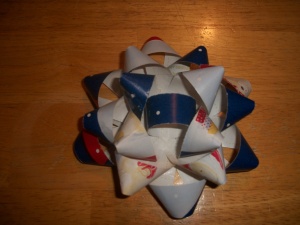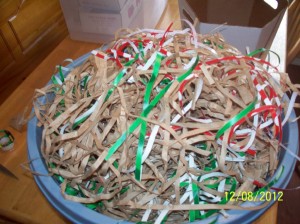Previous Chapters: one and two.
Chapter 3: Walking the Walk
Last night, Angus went knocking on Death’s door and he was welcomed with open arms. The struggle had gone on for weeks, but finally Angus has been relieved. Since there is nothing left of his red body, we’re having more of a ceremony than a burial. Where would we even bury a body anyway? Any place here would be a disgrace. Most around here deserve better than that.
Hardly anyone showed because they are tired of being confronted by what they are trying to avoid. Ever since I had met Angus in the dumpster, he was bitter about the end he knew would come. He lost his hope of being rescued when he left the city. I realize that I have lost hope. The trash around here has tried to convince me that it’s hopeless and I have let them.
Fiona was at the funeral and afterwards she comes up to me.
“Hey. I haven’t seen you around in a while,” I say.
“Yeah, I’ve been doing some thinking,” she responds. “You were right. Not about people coming to get us because that is obviously never going to happen, but about being such an optimist. We shouldn’t accept our fate. We may not be rescued by someone else, but we can still rescue ourselves. We can go to the recycling center. We can have a new life. Angus’ death helped me realize that I don’t want to die here. I would rather die trying to get out then to die here.”
“Wow, I didn’t see this coming,” I pause to consider the idea, “I don’t think this is a good idea.”
“Are you kidding? You would rather putrefy in this God forsaken place then just take a chance? If you stay here you will die. You talked to Polly; no one comes here. If you want to get out, you have to get yourself out,” she says, each word getting louder.
I consider what she has said then shake my head.
“I can’t. For me it’s the opposite of what you’ve said. I’m only a spoon. I’m not smart like you. I know that if I try to get out then I will die, but if I wait someone could come.” I say still hopeful.
“God. If you would take some of that belief you have in other people that care nothing about you and invest it in yourself, you could be a lot more productive. But whatever, it’s your choice. I’ll be leaving for the recycling center in a couple of days, so when you decide to stop being a coward come and find me,” she tells me.
She leaves me stunned and all I can do is watch her go. There was no point in me chasing after her, so I just went back to the bag I had found and started to live in. She is right. I am a coward and she probably is also right about no one coming to save me. If I want a chance then I’ll have to fight for it because no one else is going to give it to me. That’s all life has been shouting at me since the day I was made. She is right. The question is will I have the courage to do anything about it.
I look across the mountain of waste that is viewable from my bag; most of it is lost forever. I still have the ability to change my situation, but in a few months I’ll be so broken I won’t even be able to turn my head from the mountain. I realize now that I would much rather be dead than being a miserable rot. I won’t give myself time to second guess, but there is something I need to do first.
I start to ascend the mountains on the way to the island that Fiona had brought me to a few weeks ago. At the peak of the mountain, I immediately spot Polly who now looked so much worse. She may not be able to decompose, but she is now broken into many more pieces. Even as I stand before her, she doesn’t look up.
“Polly,” I say quietly.
Her eyes rise slowly and lock with mine. They are lifeless.
“Fiona and I are going to try and escape. We’re going to the recycling center. I want you to come with us,” I say, still quiet.
She says nothing and she gives no indication that she will even consider my proposal.
“We may not make it. We probably won’t. But I would rather die out there with hope than die in here like we are right now,” I say.
I stop to let what I’ve said soak in. She gives no response.
“We’ll be leaving tomorrow morning. I desperately hope you will meet and come with us,” I say and leave her to consider my offer.
I wake up to the sound of birds crying. Sometimes I wish they would cry for justice for us, but even if they were, no one is around to hear them. I groan in contempt for what I hope is the last time. I don’t have to walk far before I see Fiona; even from far away I can see her screen beaming with delight. I rush to her and hug her as if my life depends on it. It does depend on her.
“Is Polly coming?” I ask hopefully.
Her face fell. “No. This morning some more trash trucks came in and the island was buried. She is stuck. There is really no hope for her now.”
She saw the guilt covering my face.
“You tried to get her to come. She had already made her decision then. If she had already decided to come then she wouldn’t have been on the island anyway. There is nothing you could have done,” she says pulling me toward the entrance of the landfill.
Miles stand between us and our destination.
We are now almost there, but it’s about to get far more dangerous. We hear a horrid screeching of a trash trucks coming our way. We start to run, but it is already too late. We get thrown to the ground, pounded into the top layers of trash. The sound is deafening; it’s like being at the bottom of hundreds of waterfalls. Fiona yells something at me, but I can’t hear her. I feel like I’m being broken in half. An eternity goes by, but finally, it’s over. Fortunately, I’m not packed in the trash and I can start to wiggle my way out. When I reach the top, I see Fiona standing. I am thoroughly relieved, but I am noticing a crack splitting her face.
“What happened?” I ask rushing to her.
“Well, I managed to stay on top by wiggling my way up layer by layer instead of waiting and letting trap me at the bottom. It came with a price because it all fell directly on me instead of letting the upper layer take some of the blows,” she cackles from her microphone.
“Come on we need go before they come back.”
As we walk, she has to continuously wipe the chemicals off because they’re blinding her only eye as they poor down her face.
We have made it outside the gates that have surrounded us for all this time. We are met with deserted land. Spaceless, timeless, but we hear the noise from the busy streets even as they are so far away. We run towards that noise as if its energy is what will keep us alive; the noise guides like the North Star. I stop just before we are within the drivers’ view.
“Wait! Won’t they thinks unnatural for us to be up and walking around,” I ask with sudden panic.
She, once again, bursts into laughter. I’m really tired of that.
“You’re still so pathetic. Haven’t I convinced you already? No one cares about us. All that,” she waves behind her, “what we just came from, the pollution, the smells, the health problems, all of it has been happening right under their noses. They haven’t noticed and if they have then they don’t care. They’re busy. They have no time to care about anything, but their own problems. I assure you, they’re not going to notice a couple of pieces of ‘misplaced’ litter.”
That settles that. Once again, believing in people has made me an idiot.
Cars are backed up, bumper to bumper and the traffic is going nowhere. We choke on the obnoxious fumes. It’s deafening, but we decide that it was the best time to move since the cars weren’t moving. We walk across the lanes of cars, slowly, but somewhat safely. The light turns green and it doesn’t take much to realize that we’re out of time. I quickly move to the middle of the lane, so that I won’t be stuck where the tires were. Fiona was not as lucky though. I turn in horror to see just as a set of tires roll over her and I hear her frame crack.
“Fiona!” I cry running to her. I barely escape my own set of tires, but I get to her and drag her to the middle of the lane. We can wait until the traffic dies down and get across safely.
The light turns red which is our only chance we have to make it. I haul her to the curb where we both collapse. I have never been so afraid in my life. The recycling center is only 50 feet away; its sign is a beacon. Fiona is not in good shape, but I know we can make it.
“It’s not too far. We can get there. Come on,” I say as I gather all my courage and strength to get both Fiona and myself there.
I knew she couldn’t make it without my help. We limp towards the recycling center; with each step it seems to get farther and farther away. People crowd the sidewalks and we can’t go fast enough to avoid meeting the bottom of someone’s shoe. We move over and hug the wall that lines the sidewalk. Fiona hobbled nearest to the wall and I was closest to the dangerous elements. Almost there. Five feet away, but Fiona has to stop. She’s leaking everywhere. I move over to let her have some breathing room which is the biggest mistake I could have made. Someone steps on me. Fiona was right. I don’t even think they noticed and I know for sure that they didn’t check if I was okay. I look back and realize that my handle is hanging on by a thread.
“You have to go. You have to make it,” I tell her.
“So do you! We’re almost there,” she yells trying to be heard over all the ruckus.
“Alright, come on,” I say pulling myself up.
Fiona makes it and I feel a wave of relief and I give myself permission to stop. One of us made it. That is good enough. I lie down and close my eyes. I feel pressure and a rush as I am picked up. My eyes jerk open and I find myself being put into a receptacle full of trash.
“No!” I start to yell and thrash with new found energy.
I made it all this way and it was all for nothing. Even until this moment I was naïve enough to believe that people would care. I fall on a pile of plastic. Not unlike the dumpster, the smell was overwhelming; I feel just like I did then. It’s the worst feeling, knowing I was wrong.
“What’s happening?” I ask disoriented.
“Welcome to the recycling bins. It’s where you go when someone realizes your potential,” said a plastic bottle.
I sigh with relief. I am home.








